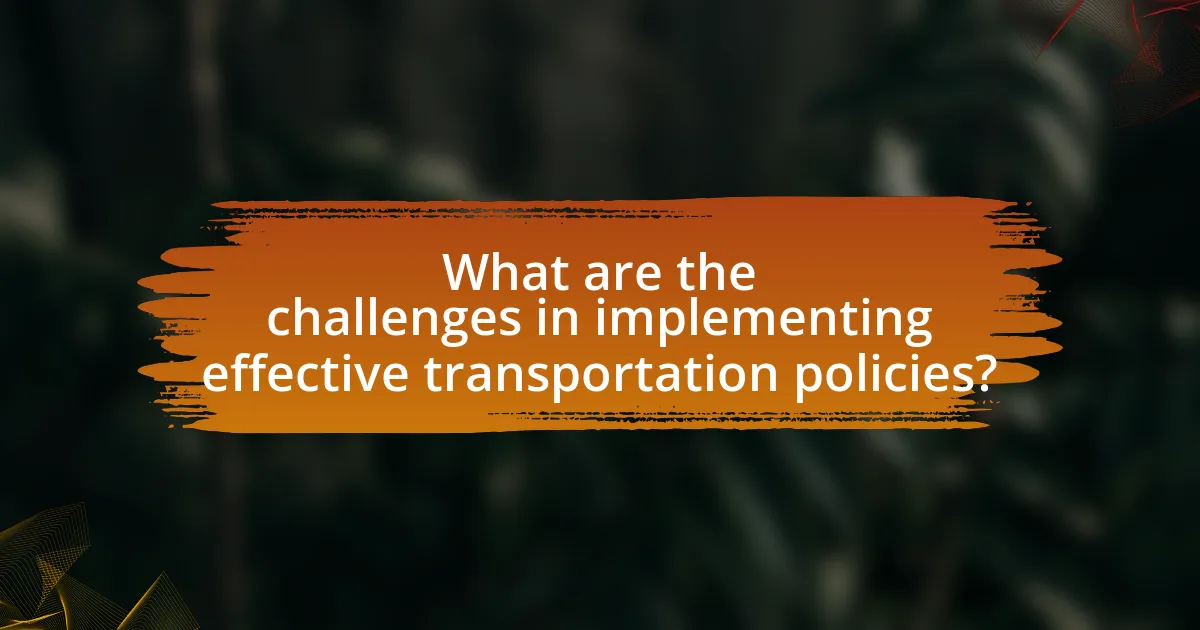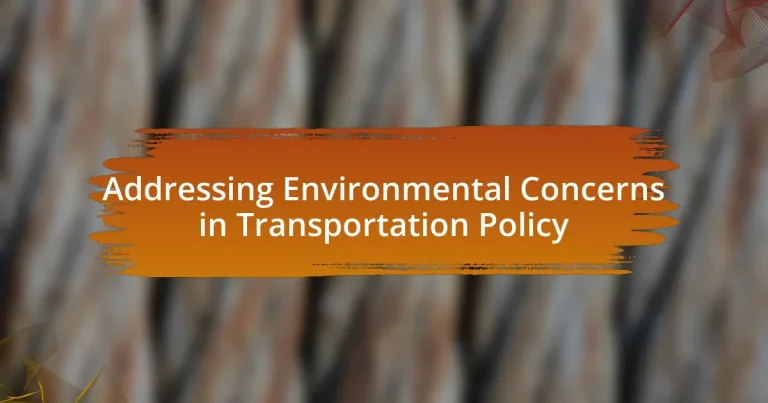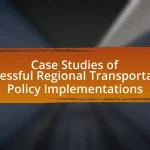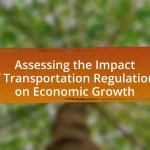The article focuses on addressing environmental concerns in transportation policy, highlighting key issues such as greenhouse gas emissions, air quality degradation, noise pollution, and habitat disruption. It details the significant contribution of the transportation sector to climate change, accounting for approximately 29% of total U.S. greenhouse gas emissions. The article explores the primary sources of these emissions, the role of urban planning in promoting sustainable transportation, and the benefits of public transit. Additionally, it discusses strategies for reducing emissions, including the promotion of electric vehicles and public transportation systems, while emphasizing the importance of stakeholder engagement and data-driven decision-making in developing effective transportation policies.

What are the key environmental concerns in transportation policy?
Key environmental concerns in transportation policy include greenhouse gas emissions, air quality degradation, noise pollution, and habitat disruption. Greenhouse gas emissions from vehicles contribute significantly to climate change, with the transportation sector accounting for approximately 29% of total U.S. greenhouse gas emissions in 2020. Air quality degradation arises from pollutants such as nitrogen oxides and particulate matter, which can harm public health and ecosystems. Noise pollution from transportation infrastructure affects wildlife and human communities, while habitat disruption occurs when transportation projects fragment ecosystems and threaten biodiversity. These concerns necessitate comprehensive policies aimed at reducing environmental impacts and promoting sustainable transportation solutions.
How do transportation emissions impact climate change?
Transportation emissions significantly contribute to climate change by releasing greenhouse gases, primarily carbon dioxide, into the atmosphere. In 2020, the transportation sector accounted for approximately 29% of total greenhouse gas emissions in the United States, making it a major source of pollution. These emissions trap heat in the atmosphere, leading to global warming and associated climate impacts such as extreme weather events, rising sea levels, and ecosystem disruptions. The Intergovernmental Panel on Climate Change (IPCC) emphasizes that reducing transportation emissions is crucial for meeting global climate targets and mitigating adverse environmental effects.
What are the primary sources of transportation emissions?
The primary sources of transportation emissions are road vehicles, aviation, shipping, and rail transport. Road vehicles, including cars and trucks, contribute the most significant share of transportation emissions, accounting for approximately 72% of total transportation greenhouse gas emissions in the United States as of 2020. Aviation is responsible for about 11% of these emissions, while shipping contributes around 10%, and rail transport accounts for approximately 2%. These figures highlight the dominant role of road vehicles in transportation emissions, underscoring the need for targeted policies to address their environmental impact.
How do transportation emissions compare to other sectors?
Transportation emissions account for approximately 29% of total greenhouse gas emissions in the United States, making it the largest contributor among economic sectors. In comparison, electricity generation contributes about 25%, followed by industry at 23%, residential at 12%, and agriculture at 10%. This data highlights the significant role transportation plays in overall emissions, underscoring the need for targeted policies to reduce its environmental impact.
What role does urban planning play in transportation policy?
Urban planning plays a critical role in shaping transportation policy by integrating land use and transportation systems to promote sustainable mobility. Effective urban planning ensures that transportation networks are designed to reduce congestion, enhance accessibility, and minimize environmental impacts. For instance, studies show that cities with well-planned public transit systems experience lower greenhouse gas emissions and improved air quality, as seen in cities like Portland, Oregon, where transit-oriented development has led to a 20% reduction in per capita emissions since 1990. This demonstrates that urban planning directly influences transportation policy outcomes by prioritizing environmentally friendly practices and efficient resource use.
How can urban design reduce transportation-related emissions?
Urban design can reduce transportation-related emissions by promoting compact, mixed-use development that encourages walking, cycling, and the use of public transit. This approach minimizes the need for car travel, which is a significant source of greenhouse gas emissions. For instance, cities designed with accessible public transportation systems and pedestrian-friendly infrastructure can lead to a reduction in vehicle miles traveled. Research indicates that urban areas with higher density and mixed land uses can reduce per capita emissions by up to 30% compared to sprawling suburbs. Additionally, integrating green spaces and sustainable transportation options, such as bike lanes and electric vehicle charging stations, further supports emission reduction efforts.
What are the benefits of public transportation in urban areas?
Public transportation in urban areas significantly reduces traffic congestion and lowers greenhouse gas emissions. By providing an efficient alternative to private vehicles, public transit systems can decrease the number of cars on the road, which in turn leads to less air pollution. For instance, the American Public Transportation Association reports that public transit saves approximately 45 million metric tons of carbon dioxide annually, equivalent to the emissions from 9.5 million cars. Additionally, public transportation promotes economic growth by increasing accessibility to jobs and services, which can enhance urban development and community connectivity.
Why is sustainable transportation important?
Sustainable transportation is important because it reduces greenhouse gas emissions and minimizes environmental impact. The transportation sector accounts for approximately 29% of total greenhouse gas emissions in the United States, making it a significant contributor to climate change. By promoting sustainable practices such as public transit, cycling, and electric vehicles, cities can decrease air pollution and improve public health. Furthermore, sustainable transportation enhances energy efficiency, as modes like rail and cycling consume less energy per passenger mile compared to traditional vehicles. This shift not only addresses environmental concerns but also supports economic growth through the creation of green jobs and infrastructure development.
What are the long-term benefits of sustainable transportation policies?
Sustainable transportation policies provide long-term benefits such as reduced greenhouse gas emissions, improved public health, and enhanced economic efficiency. By promoting the use of public transit, cycling, and walking, these policies significantly lower carbon emissions, contributing to climate change mitigation. For instance, a study by the American Public Transportation Association found that public transit use reduces greenhouse gas emissions by 45 million metric tons annually. Additionally, sustainable transportation improves air quality, leading to better health outcomes; the World Health Organization estimates that urban air pollution causes 4.2 million premature deaths each year. Economically, investments in sustainable transportation infrastructure yield high returns; the National Economic Council reported that every $1 billion invested in public transit creates approximately 50,000 jobs. These benefits collectively enhance the quality of life and promote sustainable urban development.
How do sustainable practices affect public health?
Sustainable practices positively affect public health by reducing pollution and promoting healthier lifestyles. For instance, the implementation of public transportation systems that prioritize eco-friendly vehicles decreases air pollutants, which are linked to respiratory diseases. A study published in the journal Environmental Health Perspectives found that reducing vehicle emissions can lead to a significant decrease in asthma rates among urban populations. Additionally, sustainable urban planning encourages walking and cycling, which increases physical activity levels, thereby reducing obesity and related health issues. The World Health Organization has reported that active transportation can lead to a 20% reduction in the risk of chronic diseases.

What strategies can be implemented to address these concerns?
To address environmental concerns in transportation policy, implementing strategies such as promoting public transit, enhancing fuel efficiency standards, and incentivizing electric vehicle adoption is essential. Public transit systems reduce individual car usage, leading to lower emissions; for instance, the American Public Transportation Association reports that public transit saves 45 million metric tons of CO2 annually. Enhancing fuel efficiency standards, as seen in the Corporate Average Fuel Economy (CAFE) regulations, can significantly decrease greenhouse gas emissions from vehicles. Additionally, providing incentives for electric vehicle adoption, such as tax credits and rebates, encourages consumers to choose cleaner alternatives, contributing to a reduction in air pollution and fossil fuel dependency. These strategies collectively create a more sustainable transportation framework.
How can governments promote electric vehicles?
Governments can promote electric vehicles by implementing financial incentives, such as tax credits and rebates for consumers and manufacturers. For instance, the U.S. federal government offers a tax credit of up to $7,500 for the purchase of new electric vehicles, which has significantly increased sales and adoption rates. Additionally, governments can invest in charging infrastructure, making it more convenient for consumers to own electric vehicles. Research from the International Council on Clean Transportation indicates that increased charging stations correlate with higher electric vehicle adoption rates. Furthermore, governments can establish stricter emissions regulations, encouraging manufacturers to produce more electric models. These strategies collectively contribute to a more favorable environment for electric vehicle adoption, addressing environmental concerns in transportation policy.
What incentives can encourage the adoption of electric vehicles?
Financial incentives such as tax credits, rebates, and grants can significantly encourage the adoption of electric vehicles (EVs). For instance, the U.S. federal government offers a tax credit of up to $7,500 for the purchase of new electric vehicles, which has been shown to increase consumer interest and sales. Additionally, many states provide further incentives, such as rebates that can range from $1,000 to $5,000, making EVs more financially accessible. Research indicates that these financial incentives can lead to a substantial increase in EV market share; for example, a study by the International Council on Clean Transportation found that states with robust incentive programs saw EV sales increase by over 50% compared to those without such programs.
How does charging infrastructure impact electric vehicle usage?
Charging infrastructure significantly impacts electric vehicle (EV) usage by directly influencing the convenience and accessibility of charging options for users. A well-developed network of charging stations reduces range anxiety, which is a major barrier to EV adoption; studies indicate that 80% of potential EV buyers cite charging availability as a critical factor in their decision-making process. Furthermore, regions with extensive charging infrastructure report higher EV adoption rates; for example, California, which has over 70,000 charging stations, leads the U.S. in EV registrations, demonstrating a clear correlation between charging availability and increased EV usage.
What are the benefits of investing in public transportation systems?
Investing in public transportation systems significantly reduces traffic congestion and greenhouse gas emissions. Public transit can lower individual car usage, which accounts for approximately 29% of total greenhouse gas emissions in the United States. Studies show that public transportation can reduce carbon dioxide emissions by 45 million metric tons annually, equivalent to the emissions produced by 9 million cars. Additionally, efficient public transit systems promote economic growth by providing access to jobs and services, which can lead to increased productivity and reduced economic disparities. Furthermore, public transportation investments can enhance urban mobility, improve air quality, and foster sustainable community development.
How can improved public transit reduce traffic congestion?
Improved public transit can significantly reduce traffic congestion by providing a reliable alternative to single-occupancy vehicles. When public transit systems are enhanced, they attract more riders, which decreases the number of cars on the road. For instance, a study by the American Public Transportation Association found that public transit use can reduce congestion by up to 45% during peak hours in urban areas. Additionally, efficient public transit systems can lead to shorter travel times and lower emissions, further encouraging people to opt for these services over personal vehicles. This shift not only alleviates traffic but also contributes to environmental sustainability by reducing greenhouse gas emissions associated with road traffic.
What funding models support public transportation initiatives?
Public transportation initiatives are supported by various funding models, including government grants, public-private partnerships, fare revenues, and dedicated taxes. Government grants, such as those from the Federal Transit Administration in the United States, provide significant financial resources for transit projects, often covering a substantial portion of capital costs. Public-private partnerships leverage private investment to enhance service delivery and infrastructure development, allowing for shared financial risk and innovation. Fare revenues generated from ticket sales contribute to operational funding, while dedicated taxes, such as sales taxes or vehicle registration fees, create a stable funding source specifically earmarked for public transit. These models collectively ensure the sustainability and expansion of public transportation systems, addressing both environmental concerns and community mobility needs.
How can policy frameworks support sustainable transportation?
Policy frameworks can support sustainable transportation by establishing regulations and incentives that promote environmentally friendly practices. For instance, governments can implement policies that encourage the use of public transit, cycling, and walking, thereby reducing reliance on fossil fuel-powered vehicles. Evidence from the International Energy Agency indicates that countries with comprehensive transportation policies, such as those promoting electric vehicles and renewable energy sources, have seen significant reductions in greenhouse gas emissions. Additionally, funding for infrastructure improvements, such as bike lanes and electric vehicle charging stations, can further enhance sustainable transportation options.
What role do regulations play in shaping transportation policies?
Regulations play a critical role in shaping transportation policies by establishing standards and guidelines that govern the design, operation, and environmental impact of transportation systems. These regulations ensure compliance with safety, efficiency, and environmental protection measures, which are essential for sustainable transportation development. For instance, the Clean Air Act in the United States mandates emissions standards for vehicles, directly influencing transportation policies to prioritize cleaner technologies and reduce air pollution. Additionally, regulations such as the National Environmental Policy Act require federal agencies to assess the environmental effects of their transportation projects, thereby integrating environmental concerns into policy-making processes.
How can stakeholder engagement enhance policy effectiveness?
Stakeholder engagement enhances policy effectiveness by ensuring that diverse perspectives and expertise are incorporated into the decision-making process. This inclusion leads to more informed policies that address the specific needs and concerns of affected communities. For instance, research by the International Association for Public Participation indicates that policies developed with stakeholder input are more likely to achieve desired outcomes and gain public support, as they reflect the values and priorities of those impacted. Engaging stakeholders also fosters collaboration, which can lead to innovative solutions and increased accountability in policy implementation.

What are the challenges in implementing effective transportation policies?
Implementing effective transportation policies faces several challenges, including funding constraints, stakeholder opposition, and technological limitations. Funding constraints often hinder the development and maintenance of infrastructure, as seen in the American Society of Civil Engineers’ 2021 report, which estimated a $2.59 trillion investment gap in U.S. infrastructure over the next decade. Stakeholder opposition arises from conflicting interests among various groups, such as local communities, businesses, and environmental advocates, making consensus difficult. Additionally, technological limitations can impede the adoption of innovative solutions, as many regions lack the necessary data and tools to implement smart transportation systems effectively. These factors collectively complicate the creation and execution of transportation policies that address environmental concerns.
What barriers exist to adopting sustainable transportation practices?
Barriers to adopting sustainable transportation practices include high initial costs, lack of infrastructure, and insufficient public awareness. High initial costs deter individuals and organizations from investing in sustainable options, such as electric vehicles or public transit systems. Lack of infrastructure, such as charging stations for electric vehicles or dedicated bike lanes, limits the practicality of sustainable transportation. Additionally, insufficient public awareness about the benefits of sustainable practices hinders widespread adoption, as many individuals may not understand the long-term economic and environmental advantages. According to a report by the International Energy Agency, the upfront cost of electric vehicles remains a significant barrier, with prices often exceeding those of traditional vehicles.
How do economic factors influence transportation policy decisions?
Economic factors significantly influence transportation policy decisions by determining funding availability, prioritizing infrastructure investments, and shaping regulatory frameworks. For instance, budget constraints often lead policymakers to favor cost-effective transportation solutions, such as public transit systems, over more expensive options like highway expansions. Additionally, economic growth can drive demand for improved transportation networks, prompting governments to allocate resources towards projects that enhance connectivity and efficiency. Historical data shows that during economic downturns, transportation budgets are frequently reduced, impacting project timelines and scope, as seen in the 2008 financial crisis when many infrastructure projects were delayed or scaled back due to budget shortfalls.
What social factors affect public acceptance of new transportation policies?
Public acceptance of new transportation policies is significantly influenced by social factors such as community engagement, perceived fairness, and cultural values. Community engagement fosters trust and allows residents to voice their concerns, which can lead to greater support for policies. Perceived fairness relates to how equitably the benefits and burdens of transportation changes are distributed among different social groups; policies seen as fair are more likely to gain acceptance. Cultural values shape attitudes towards transportation modes and environmental concerns, with communities prioritizing sustainability often more receptive to innovative policies. Research indicates that these social dynamics play a crucial role in shaping public opinion and acceptance of transportation initiatives.
How can policymakers overcome resistance to change?
Policymakers can overcome resistance to change by actively engaging stakeholders and fostering collaboration. Engaging stakeholders, including community members, businesses, and environmental groups, allows policymakers to understand concerns and incorporate feedback, which can lead to greater acceptance of new policies. For instance, the implementation of California’s cap-and-trade program involved extensive stakeholder consultations, resulting in broader support and smoother execution. Additionally, providing clear evidence of the benefits of proposed changes, such as improved air quality and reduced traffic congestion, can help alleviate fears and misconceptions. Research indicates that transparent communication and demonstrating tangible benefits significantly enhance public buy-in for environmental policies.
What strategies can be used to educate the public about transportation issues?
Effective strategies to educate the public about transportation issues include community engagement initiatives, educational campaigns, and the use of digital platforms. Community engagement initiatives, such as public forums and workshops, allow citizens to discuss transportation challenges and solutions directly with policymakers, fostering a sense of involvement and ownership. Educational campaigns can utilize brochures, flyers, and public service announcements to disseminate information about the environmental impacts of transportation choices, highlighting statistics such as the fact that transportation accounts for approximately 29% of greenhouse gas emissions in the United States. Digital platforms, including social media and dedicated websites, can provide accessible information and interactive tools, enabling the public to understand transportation issues and their implications on the environment. These strategies collectively enhance public awareness and encourage informed decision-making regarding transportation policies.
How can successful case studies influence policy adoption?
Successful case studies can significantly influence policy adoption by providing empirical evidence of effective strategies and outcomes. For instance, a case study demonstrating the successful implementation of electric buses in a city can showcase reduced emissions and cost savings, thereby encouraging policymakers to adopt similar measures. Research indicates that case studies serve as practical examples that illustrate the feasibility and benefits of proposed policies, making them more relatable and persuasive to decision-makers. Furthermore, successful case studies often highlight stakeholder engagement and community support, which are critical factors in the policy adoption process.
What best practices can guide the development of transportation policies?
Best practices that can guide the development of transportation policies include stakeholder engagement, data-driven decision-making, and sustainability integration. Stakeholder engagement ensures that the voices of communities, businesses, and experts are considered, leading to more effective and accepted policies. Data-driven decision-making relies on accurate data analysis to inform policy choices, enhancing their effectiveness and efficiency. Sustainability integration involves incorporating environmental considerations into transportation planning, which is essential for reducing carbon emissions and promoting eco-friendly practices. For instance, the implementation of the Paris Agreement emphasizes the need for countries to adopt sustainable transportation policies to meet climate goals.
How can data-driven decision-making improve transportation outcomes?
Data-driven decision-making can significantly improve transportation outcomes by optimizing resource allocation and enhancing operational efficiency. By analyzing real-time data on traffic patterns, public transit usage, and environmental impacts, transportation agencies can make informed decisions that reduce congestion and emissions. For instance, a study by the Texas A&M Transportation Institute found that data analytics can lead to a 20% reduction in travel time and a 15% decrease in fuel consumption when applied to traffic management systems. This evidence demonstrates that leveraging data not only streamlines transportation processes but also contributes to more sustainable practices, aligning with environmental policy goals.
What role does community involvement play in policy success?
Community involvement is crucial for policy success, particularly in addressing environmental concerns in transportation policy. Engaging the community fosters trust, ensures that diverse perspectives are considered, and enhances the legitimacy of the policy-making process. Research indicates that policies developed with active community participation are more likely to be accepted and effectively implemented. For instance, a study by the National Academy of Sciences found that community engagement in transportation planning leads to better outcomes, as it aligns policies with the actual needs and values of the community, ultimately resulting in increased public support and compliance.


